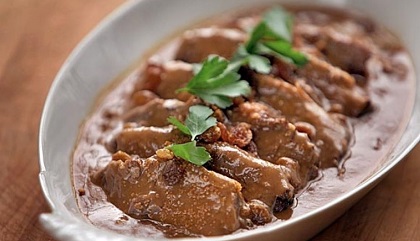
Sauerbraten, a gem in the crown of German cuisine, is a pot roast, usually of beef (but other meats such as lamb, mutton, pork, and traditionally, horse), marinated before slow-cooking as pot roast. The meat is typically marinated for several days in a mixture of vinegar or wine, water, herbs, spices, and seasonings before being slow-cooked. The result is a dish that is at once tangy, savory, tender, and richly flavored, a testament to the depth of traditional German cooking.
The Historical Roots of Sauerbraten: Sauerbraten has been a staple in German culinary traditions for centuries, often linked to celebrations and feasts. It is said that Julius Caesar may have sent the earliest recipe for this dish from Rome to the Cologne region. The word “Sauerbraten” itself can be dissected into “Sauer” meaning sour or pickled, and “Braten,” meaning roast meat.
Ingredients:
- 2-3 pounds beef roast (rump roast or chuck roast preferred)
- 2 onions, coarsely chopped
- 1 carrot, coarsely chopped
- 1 celery stalk, coarsely chopped
- 1 leek, coarsely chopped (optional)
- 1 cup red wine vinegar
- 1 cup dry red wine
- 2 cups water
- 2 bay leaves
- 6 whole cloves
- 6 black peppercorns
- 2 juniper berries (optional)
- 1 teaspoon mustard seeds
- 1/2 teaspoon salt
- 1/4 teaspoon black pepper
- 2 tablespoons vegetable oil
- 2 tablespoons flour
- 2 tablespoons sugar
- 1/2 cup raisins (optional)
- 1/2 cup crushed ginger snaps (for thickening and flavor)
- Salt and pepper to taste
Marinating the Meat:
- In a large bowl or resealable plastic bag, combine the vinegar, red wine, water, onions, carrot, celery, leek, bay leaves, cloves, peppercorns, juniper berries, mustard seeds, salt, and black pepper.
- Place the beef roast into the marinade, ensuring it is completely submerged. Cover or seal and refrigerate for 2 to 5 days, turning the meat daily.
Preparing the Sauerbraten:
- Remove the beef from the marinade and pat dry with paper towels. Strain the marinade, reserving the liquid and the vegetables separately.
- In a large Dutch oven or heavy-bottomed pot, heat the vegetable oil over medium-high heat. Brown the roast on all sides, creating a rich, caramelized crust.
- Remove the beef and set aside. In the same pot, sauté the strained vegetables until they start to brown.
- Sprinkle flour over the vegetables and stir, cooking for a minute to create a roux.
- Slowly add the reserved marinade liquid to the pot, stirring constantly to avoid lumps.
- Return the beef to the pot. Bring the liquid to a low simmer, cover, and cook for 3 to 4 hours, or until the beef is very tender. If using a slow cooker, you can cook on low for 8 hours or on high for 4 hours.
Creating the Signature Sauce:
- Once the beef is tender, remove it from the pot and tent with foil to keep warm.
- Strain the cooking liquid and return it to the pot, discarding the solids.
- Add sugar and raisins (if using) to the strained liquid and bring to a simmer.
- To thicken the sauce and add a unique flavor, stir in the crushed ginger snaps until dissolved. Adjust the seasoning with salt and pepper.
- Slice the beef and serve with the sauce poured over the top.
Serving Suggestions: Traditional accompaniments for Sauerbraten include red cabbage, boiled potatoes, spaetzle, or potato dumplings. The contrast between the tangy sauce and the mellow side dishes makes for a harmonious plate that’s deeply satisfying.
The Legacy of Sauerbraten
Sauerbraten is more than just a meal; it’s a cultural artifact that has endured through the ages, adapting to the tastes and techniques of each generation while retaining its essence. It is a dish that demands patience and respect for the process, which in turn, rewards you with flavors and textures that are undeniably worth the wait.
This traditional Sauerbraten recipe is a celebration of German heritage, a hearty dish that fills the home with mouthwatering aromas and the belly with warmth. Whether it’s your first time making it or it’s a recipe that’s been handed down through your family, each bite is a taste of history.
Related articles:
15 Best German Christmas Recipes
Authentic Königsberger Klopse
How to Cook Sauerbraten
Easy Homemade German Spaetzle Recipe
